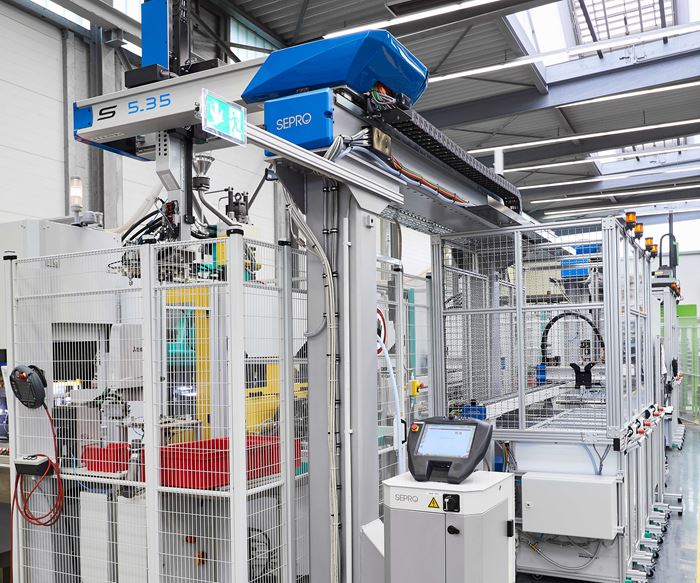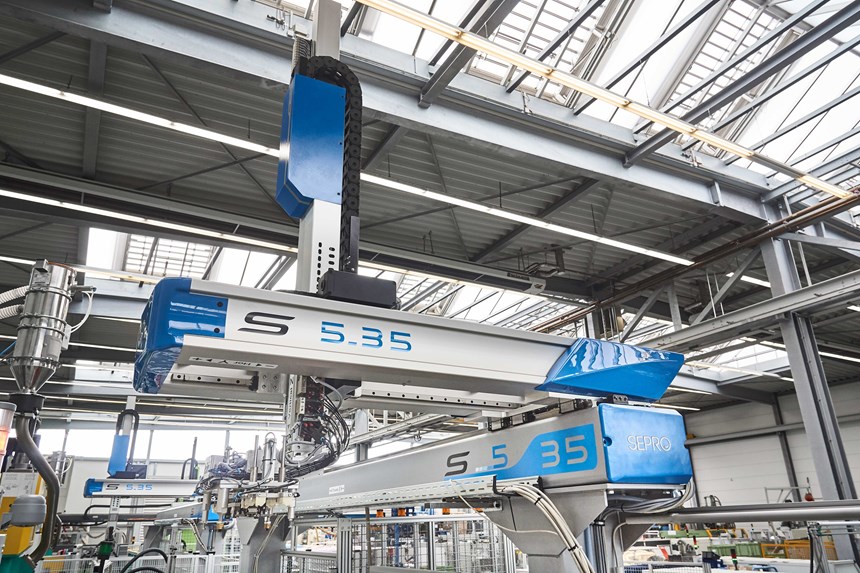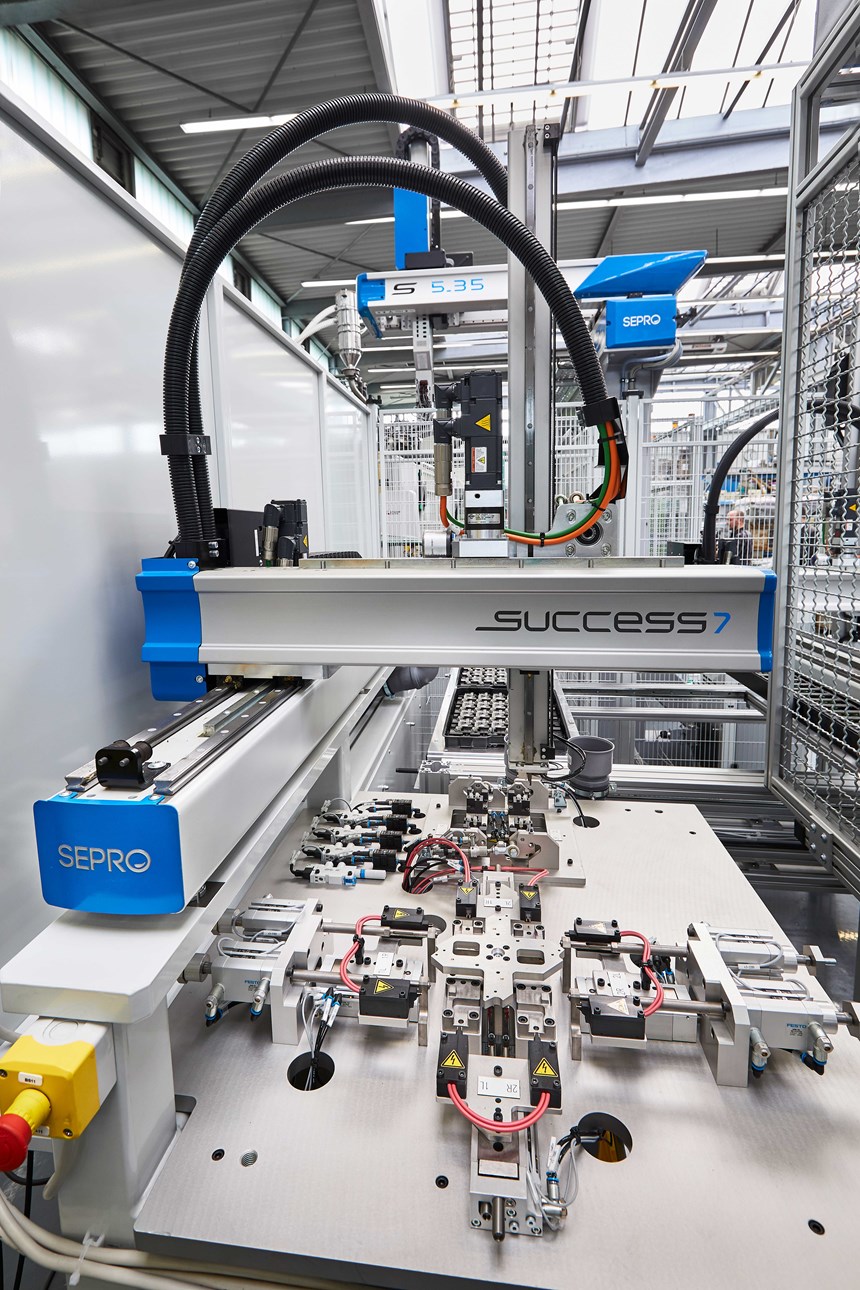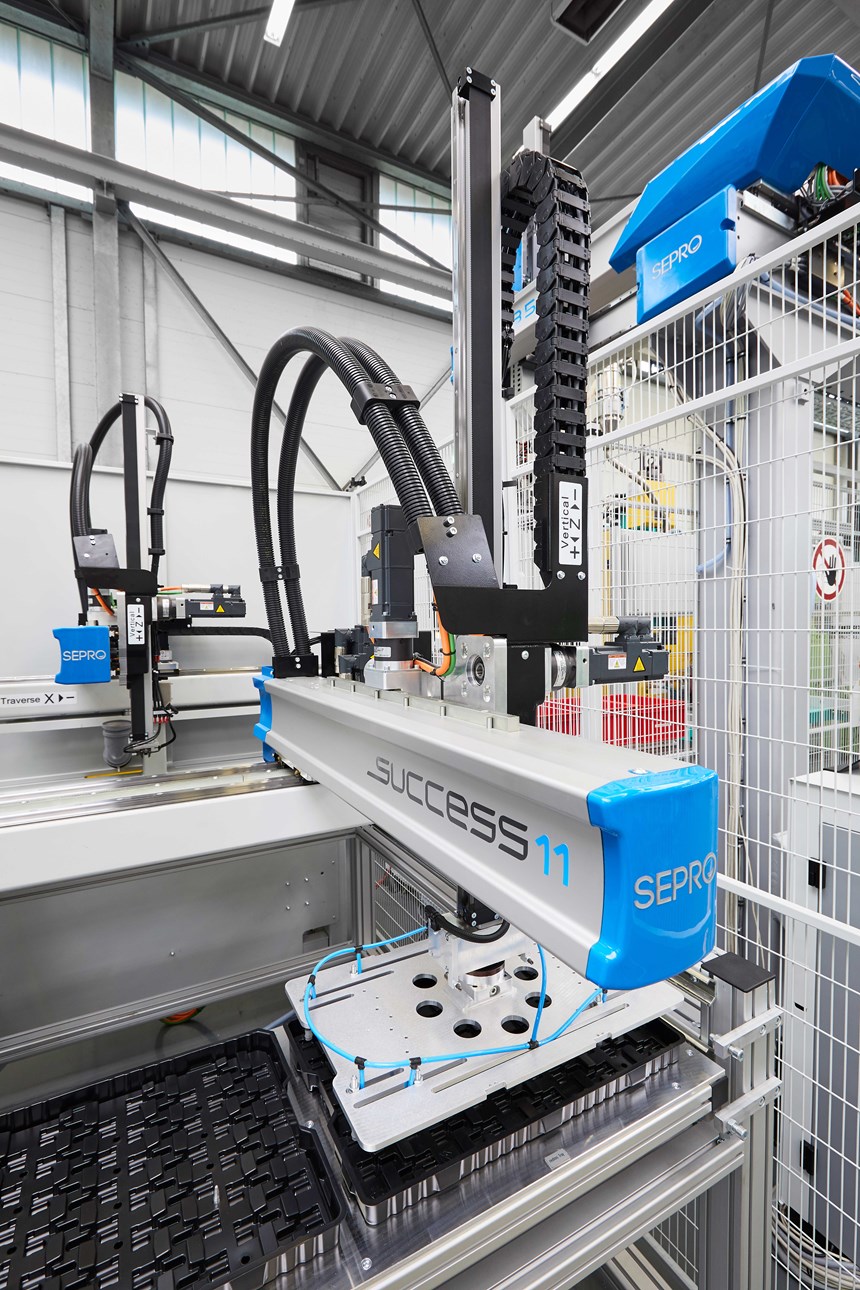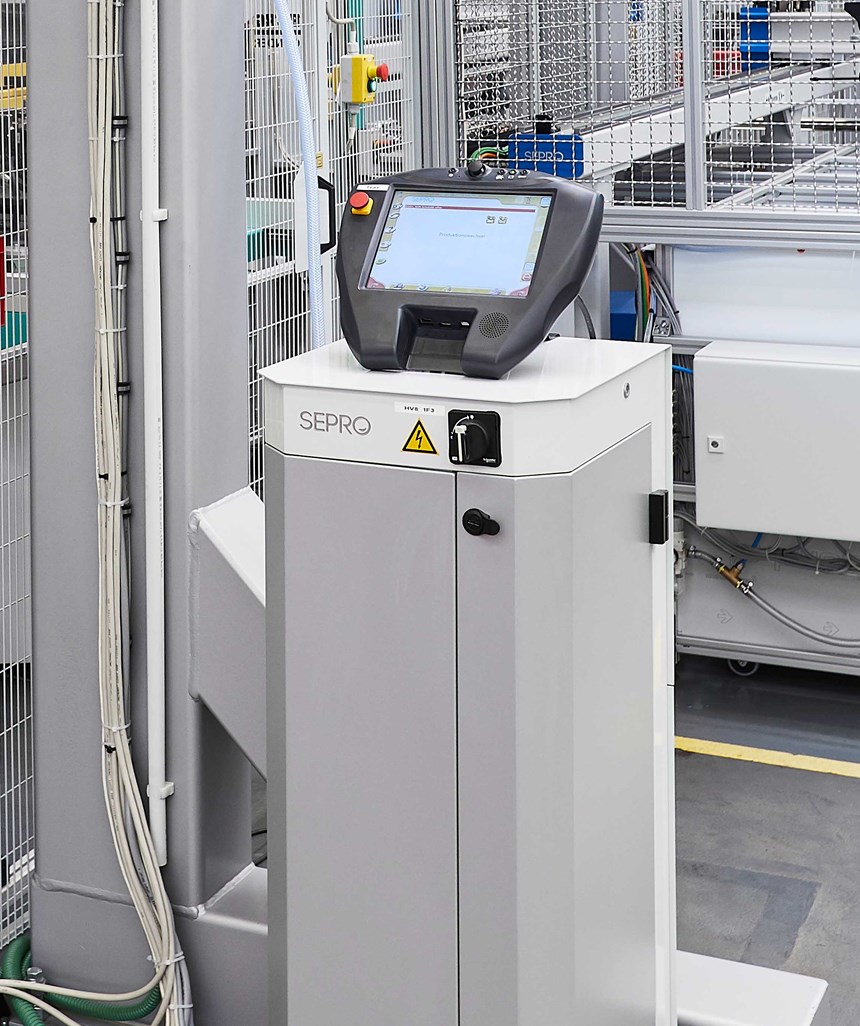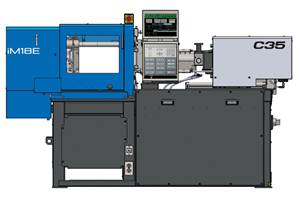Simplicity Conquers Complexity in Automotive Molding Cells
Six-axis robots are often recommended for complex automation cells, but here’s an example of how cost-effective, three-axis linear robots can be up to the task.
Two identical, highly compact vertical injection molding cells are among the most recent additions to the KHG Plastics GmbH plant in Velberg, Germany. The new cells, which together can produce some 40,000 overmolded electrical contacts per week for automotive lighting systems, combine a sequence of metal fabrication, overmolding, testing and packaging into fully automated production. And, they do so with elegance and simplicity.
Originally, the company considered moving parts through these diverse functions with the help of two six-axis robots, a human operator, and additional automation. But a much simpler proposal, evolved by robot maker Sepro and Kiki, a local systems integrator, convinced KHG Plastics that the cells would be more compact and productive using three linear, three-axis robots, all integrated through a single control system. This solution offers a tip to other molders on how unconventional approaches can lead to success.
AUTOMATING MULTIPLE FUNCTIONS
After winning the chance to produce a new overmolded metal contact for an automaker’s vehicle lighting systems, KHG got to work designing the production system for this part. The company sought a fully automated process that would integrate a variety of production equipment:
• A metal-punching and bending machine to receive metal blanks and produce left- and right-oriented metal contacts;
• A vertical injection molding machine to receive and overmold the metal stampings;
• A test station to short-circuit test the overmolded contacts;
• A packaging station where “good” right-hand and left-hand parts are transferred into stackable trays that can be moved to further automation in-house or palletized and shipped to the customer.
Since the application involved moving parts through a series of pre-and post-mold operations, the company considered an initial proposal that envisioned the use of two six-axis robots, which would offer 360° of operational reach along with the ability to handle even the most complex part manipulations. This approach suggested that one large, centrally located, six-axis robot could do the bulk of the work, handling parts from the stamping machine through overmolding to the testing apparatus. From there, a smaller six-axis robot would remove the parts and load them into trays, which would proceed to an automatic tray-stacker and onto carts for removal.
Though the logic of the proposal was clear, company officials had questions and sought input from other trusted business partners. Based on past experience, they asked Sepro if largest six-axis robot could be replaced by a linear robot.
After considering the company’s requirements and comparing alternatives, Marius Svagnea, area sales manager for Sepro, replied “Yes.” His analysis found that a Sepro linear robot—a three-axis model S5-35—could replace the large six-axis robot at the center of the cell, reducing footprint requirements and allowing easier access for mold changes, maintenance and service to the bending, molding and testing equipment in the cell.
As discussions proceeded, Svagnea proposed using a second linear robot—a smaller Success 7—to handle tested parts instead of the smaller six-axis robot. Finally, a Success 11 was added to flexibly automate parts-tray handling. Because the linear robots could be positioned above the molding machines, they would simplify machinery placement, reduce floorspace requirements, and improve access. Reach would be no problem, since their horizontal beams could be of any length required.
KHG was impressed by the logic: “We saw that a six-axis robot would have taken too much space and had too limited a reach, said CEO Lutz Karrenberg. “The Sepro/Kiki solution combined several standard robots in a very small space. This was the main reason behind our decision.”
Karrenberg added, "We did not necessarily at first think of a solution with a tray cart that would include loading via a third robot system. This idea came completely from Sepro, who had already implemented something of a similar nature. This solution not only saved us a lot of space, but also optimized our workflow and brought a high flexibility to the system for future production tasks."
CELLS IN OPERATION
Each robot has its own Sepro Visual control, and each is individually programmed to perform its own functions within the cell. However, the Visual 3 control on the first and largest robot, the Sepro S5-35, also functions as the “master” robot control, coordinating cell safety and robot operations.
The large Sepro S5-35 robot has a horizontal stroke of 4000 mm. In the KHG cells, this robot begins the production process, picking up four stamped and bent metal contacts (two right-hand and two left) from the shuttle table of the punching and bending unit. The robot then moves to the vertical injection molding machine. After removing four overmolded contacts from the previous cycle, it places each of the four metal contacts into the lower half of the mold that rests on the open turntable of the machine. The robot’s end-of-arm tooling holds these contacts just long enough to lock them securely into position before the mold rotates into the machine for overmolding. Meanwhile, the same robot places the four finished parts onto a test station, where they are checked using a 500V short-circuit test. Then, the S5-35 “master” robot picks up the tested parts again, moving acceptable parts to a transfer station and removing failed parts from the process.
Next the Sepro Success 7 takes tested parts from the transfer station, identifies them as left-hand or right-hand parts, and places them into the appropriate part tray. This robot has a horizontal stroke of 1500 mm.
Finally, the Success 11 robot, takes over. It is responsible for moving filled trays of left- and right-hand parts to unloading stations, where it stacks full part trays onto movable carts. Then it retrieves another part tray (left or right, depending on the full tray it dropped off) from stations that contain empty trays, and places it into position on the sliding table for filling.
The only human involvement in the cell’s operations is removal of full parts trays—approximately every 6 hr.
SIMPLIFYING MULTI-MACHINE INTEGRATION
Ordinarily, integrating and controlling the operation of three robots and diverse pieces of equipment for metalworking, injection molding, electrical testing, and tray loading/stacking would require a separate PLC and extensive custom programming. However, cell designers were able to coordinate and integrate the all the key equipment in the cell by leveraging the capabilities of Sepro’s Visual 3 control.
Sepro’s latest improvement in integration, a feature set called Easy Package, encompasses not only the injection press/robot interoperability functions in Euromap 67, but adds a range of additional synchronization, control, monitoring, and data-exchange capabilities. By dramatically augmenting the functionality of E67 and evolving Euromap protocols (E79, E81), Sepro’s Easy Package not only enables and simplifies the integration and control of injection machines and robots, but also of complete production systems—like KHG’s twin production cells.
“In our opinion, the ease of integration is the big advantage of Sepro's portfolio,” said KHG’s Karrenberg. By leveraging Sepro’s integration capabilities through trusted vendors, KHG obtained two production cells that deliver more elegant, powerful, and cost-efficient results, with less programming and integration effort, than the more sophisticated systems that they first considered. Because both Sepro robots and the Visual control are designed around the needs of injection molders, initial programming, operation, and integration of multiple elements is said to be far easier, as is asset redeployment when future needs demand production changes.
Related Content
Compact Hybrid Injection Molding Machine Launched
Sumitomo Heavy Industries Ltd. (SHI) has introduced the iM18E, promising the smallest footprint in 20-ton machines.
Read MoreTransluscent Colorants for Injection Molded Parts
Ampacet’s Artemis masterbatch collection evokes the beauty of celestial phenomena.
Read MoreINEOS Styrolution to Close ABS Production in Addyston, Ohio
Company will commence a safe and responsible decommissioning process in the second quarter of 2025.
Read MoreHigh-Performance Nylons that Bridge Gap Between Nylons 6/66 and PPA
BASF’s new Ultramid T6000 and T7000 offer several performance and processing advantages.
Read MoreRead Next
Lead the Conversation, Change the Conversation
Coverage of single-use plastics can be both misleading and demoralizing. Here are 10 tips for changing the perception of the plastics industry at your company and in your community.
Read MoreMaking the Circular Economy a Reality
Driven by brand owner demands and new worldwide legislation, the entire supply chain is working toward the shift to circularity, with some evidence the circular economy has already begun.
Read More

